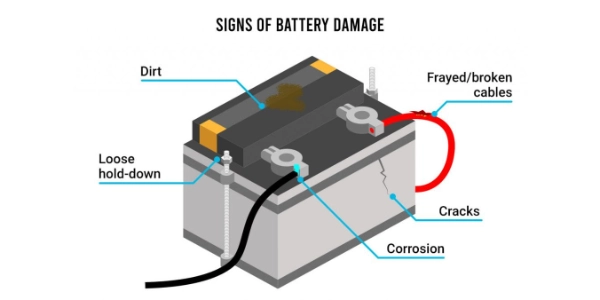Sometimes, batteries can exhibit specific symptoms that indicate their deterioration or malfunction. This article will delve into bad battery symptoms, exploring how to recognize them and providing valuable tips on fixing these issues. By understanding the signs and taking appropriate action, you can extend the lifespan of your batteries and prevent potential damage to your equipment.
Part 1. Recognizing bad battery symptoms
Draining Quickly
One of the most noticeable signs of a bad battery is its tendency to drain quickly. Find that your device’s battery life has significantly decreased, and it requires frequent recharging. It may be indicative of a failing battery. Users frequently notice this symptom in smartphones, laptops, and other portable electronic devices.
Overheating
When a battery starts to deteriorate, it often generates excessive heat during usage or charging. If you notice that your device becomes unusually hot to the touch or experiences frequent overheating issues, it could be a warning sign of a faulty battery. Overheating batteries not only impact performance but also pose a potential safety hazard.
Swelling or Bulging
A swollen or bulging battery is a clear indication of internal damage. When a battery malfunctions, it can cause the internal cells to expand, leading to physical changes in the battery’s shape. Suppose you notice any unusual bulges or swelling on your battery. In that case, it is crucial to address the issue promptly to prevent further damage or potential leaks.
Inconsistent Performance
Near the end of their lifespan, batteries often exhibit inconsistent performance. You may notice sudden drops in battery percentage, unexpected shutdowns, or unreliable power delivery. These irregularities can disrupt your workflow and compromise the overall user experience.
Part 2. Common causes of lousy battery symptoms
Age and Usage
As batteries age, their capacity to hold a charge diminishes. Regular usage and charging cycles contribute to the gradual degradation of battery performance. Over time, this wear and tear can lead to lousy battery symptoms. It is essential to consider your batteries’ age and usage patterns when evaluating their condition.
Wet Environment
Exposure to moisture and humidity can also corrode battery components, leading to performance issues.
Extreme Temperatures
Exposure to extreme temperatures, such as excessive heat or cold, can negatively impact battery performance. High temperatures can accelerate battery degradation, while cold temperatures can temporarily reduce battery life.
Low-Quality Chargers
Using low-quality or incompatible chargers can have a detrimental impact on battery health. These chargers may not deliver the appropriate voltage or current required for optimal charging, causing battery stress and premature aging.
Overcharging and Deep Discharging
Overcharging or completely discharging a battery can harm its longevity. Continuous overcharging can degrade battery cells, while deep discharges can strain the battery’s capacity to hold a charge. It is advisable to avoid extreme charging practices and maintain a balance between charge levels to preserve battery health.
Part 3. Impact of lousy battery symptoms on equipment
When bad battery symptoms go unnoticed or unaddressed, they can harm the equipment they power. Let’s explore some of the potential impacts:
Reduced Performance
Devices powered by failing batteries often experience decreased performance. Sluggish response times, slower processing speeds, and frequent crashes are common indications of an ailing battery. Replacing or fixing the battery promptly can restore your device’s optimal performance.
Data Loss
Sometimes, bad batteries can cause unexpected shutdowns or power failures, resulting in data loss. This can be particularly problematic if you still need to save your work or back up important files. Regularly backing up your data and addressing bad battery symptoms can help mitigate the risk of data loss.
Safety Hazards
Malfunctioning batteries pose safety hazards such as explosions or leaks. Overheating batteries can cause fires and harm both the device and the user. It is crucial to prioritize safety and take immediate action when bad battery symptoms arise.
Part 4. Tips for fixing bad battery symptoms
Replace the Battery
If you identify bad battery symptoms, the most effective solution is often to replace the battery entirely. Contact the device manufacturer or a reputable service center to obtain a genuine replacement battery compatible with your device. Following the manufacturer’s instructions, carefully replace the battery to restore optimal performance.
Optimize Charging Habits
It is essential to adopt healthy charging habits to prolong battery life and prevent lousy battery symptoms. Avoid overcharging or deep discharging the battery. Charge your device to the recommended levels and unplug it once fully charged. Also, high-quality chargers and cables can help maintain the battery’s health.
Keep Batteries Cool
Keeping batteries cool is crucial to prevent overheating and potential damage. Avoid exposing your devices to extreme temperatures and store them in a relaxed, well-ventilated environment. If you notice your device getting unusually hot during usage, give it a break and allow it to cool down.
Regular Maintenance
Regular device maintenance can help identify and address lousy battery symptoms early on. Monitor battery performance, monitor any changes or irregularities, and take prompt action if needed. Cleaning the battery contacts and ensuring proper connections can also contribute to optimal battery performance.
Seek Professional Assistance
If you are still trying to fix bad battery symptoms or if the symptoms persist even after attempting the tips above, it is advisable to seek professional assistance.
Part 5. Final thoughts
In conclusion, recognizing and addressing bad battery symptoms is essential for maintaining optimal device performance. By taking proactive steps such as replacing batteries, optimizing charging habits, and seeking professional assistance when needed, you can ensure extended battery life and a reliable user experience. Stay vigilant and prioritize battery health to avoid potential disruptions and maximize the longevity of your devices.
Related Tags:
More Articles

Comprehensive Guide to Choosing the Right Cart Battery
Choosing the right cart battery ensures optimal performance and longevity. This guide covers cart battery types and helps you make an informed choice.
The Ultimate Guide to 18650 Button Top Battery
18650 button top batteries are popular for their high energy density and reliability. This guide covers their key features, usage, and maintenance tips.
The Power of Slim: Unveiling the Potential of Flat Lithium Ion Battery
Flat lithium-ion batteries power devices from phones to vehicles. This article explores their design, benefits, types, applications, charging, and safety.
The Comprehensive Guide to Battery Balancing and Battery Balancer
Battery balancing and balancers optimize performance, longevity, and safety. This guide covers techniques and tips for choosing the right balancer.
10 Key Facts About Drone Battery for 2024
Uncover crucial insights with "10 Key Facts About Drone Battery for 2024." Learn the latest trends and essential details on drone batteries.




